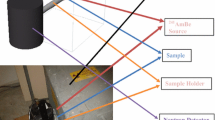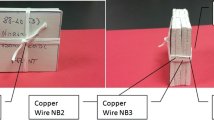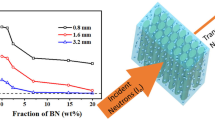Abstract
To improve properties of the nuclear reactor secondary neutron shielding material, a novel high temperature resistant shielding material was prepared, in which poly(4-methyl-1-pentene) is blended with polyethylene and polypropylene as matrix materials and boron carbide as filler. Its neutron shielding properties were analyzed by Monte Carlo simulation and tested by Am–Be neutron source. Its thermodynamic properties were tested according to standard methods. Tests show that the new material’s heat distortion temperature is up to 168 ℃, which is much higher than that of polyethylene 45 ℃ and that of polypropylene 85 ℃. The thermal neutron shielding performance of the new material is better than that of polyethylene.











Similar content being viewed by others
References
Abdulrahman ST, Ahmad Z, Thomas S et al (2020) Chapter 1—Introduction to neutron-shielding materials. In: Abdulrahman, Thottathil S, Thomas S, Ahmad Z (eds) Micro and nanostructured composite materials for neutron shielding applications. Woodhead Publishing, Sawston, pp 1–23
Wang Z, Liu C, Fang G et al (2021) Vitrification of nuclear contaminated lead–boron polyethylene. J Non Cryst Solids. https://doi.org/10.1016/j.jnoncrysol.2021.120832
Umm-E-Kulsoom GSA, Khurshid MS et al (2020) Investigating the effect of adding CdO nano particles on neutron shielding efficacy of HDPE. Radiat Phys Chem 177:109–145
Uddin Z, Yasin T, Shafiq M et al (2020) On the physical, chemical, and neutron shielding properties of polyethylene/boron carbide composites. Radiat Phys Chem 166:108–450
Tuna T, Eker AA, Kam E (2021) Neutron shielding characteristics of polymer composites with boron carbide. J Korean Phys Soc. https://doi.org/10.1007/s40042-021-00089-z
Guru S, Amritphale SS, Mishra J, Joshi S et al (2019) Multicomponent red mud-polyester composites for neutron shielding application. Mater Chem Phys. https://doi.org/10.1016/j.matchemphys.2018.12.039
Özdemir T, Akbay SK, Uzun H et al (2016) Neutron shielding of EPDM rubber with boric acid: mechanical, thermal properties and neutron absorption tests. Prog Nucl Energy 89:102–109
Mülazim Y, Kızılkaya C, Kahraman MV (2011) Thermal and neutron shielding properties of 10B2O3/polyimide hybrid materials. Polym Bull. https://doi.org/10.1007/s00289-011-0481-4
Soltani Z, Beigzadeh AM, Ziaie F et al (2016) Effect of particle size and percentages of boron carbide on the thermal neutron radiation shielding properties of HDPE/B4C composite: experimental and simulation studies. Radiat Phys Chem 127:182–187
Shin JW, Lee J-W, Yu S et al (2014) Polyethylene/boron-containing composites for radiation shielding. Thermochim Acta. https://doi.org/10.1016/j.tca.2014.03.039
Baxter L, Herrman K, Panthi R et al (2020) Chapter 3—Thermoplastic micro and nanocomposites for neutron shielding. In: Abdulrahman ST, Thomas S, Ahmad Z (eds) Micro and nanostructured composite materials for neutron shielding applications. Woodhead Publishing, Sawston, pp 53–82
Korkut T, Karabulut A, Budak G et al (2010) Investigation of fast neutron shielding characteristics depending on boron percentages of MgB2, NaBH4 and KBH4. J Radioanal Nucl Chem. https://doi.org/10.1007/s10967-010-0619-0
Adeli R, Shirmardi SP, Ahmadi SJ (2016) Neutron irradiation tests on B4C/epoxy composite for neutron shielding application and the parameters assay. Radiat Phys Chem 127:140–146
Cataldo F, Prata M (2019) New composites for neutron radiation shielding. J Radioanal Nucl Chem. https://doi.org/10.1007/s10967-019-06526-5
Griffith JH, Rånby BG (1960) Dilatometric measurements on poly(4-methyl-1-pentene) glass and melt transition temperatures, crystallization rates, and unusual density behavior. J Polym Sci. https://doi.org/10.1002/pol.1960.1204414408
Tanigami T, Yamaura K, Matsuzawa S et al (1986) Thermal expansion of crystal lattice of isotactic poly(4-methyl-1-pentene). Polym J 18:35–40
Jebaseelan Samuel EJ, Mohan S (2004) FTIR and FT Raman spectra and analysis of poly(4-methyl-1-pentene). Spectrochim Acta A 60:19–24
Bu H, Qiu W, Tan Z et al (2015) Study on toughening of poly(4-methyl-1-pentene) with various thermoplastic elastomers. J Thermoplast Compos Mater 28:1334–1342
Xu LY, Ma AP, Yin B et al (2019) The effect of alkylated graphene oxide on the crystal structure of poly(4-methyl-1-pentene) during uniaxial deformation at high temperature. Polym Compos 40:E493–E500
Guembou Shouop CJ, Ndontchueng Moyo M, Nguelem Mekongtso EJ et al (2021) 241Am/Be source optimum geometry for DSRS management-based Monte Carlo simulations. AIP Adv 11:115–124
Karimi-Shahri K, Rafat-Motavalli L, Miri-Hakimabad H (2013) Finding a suitable shield for mixed neutron and photon fields based on an Am–Be source. J Radioanal Nucl Chem. https://doi.org/10.1007/s10967-012-2225-9
Kipcak AS, Gurses P, Derun EM et al (2013) Characterization of boron carbide particles and its shielding behavior against neutron radiation. Energy Convers Manag. https://doi.org/10.1016/j.enconman.2012.08.026
Author information
Authors and Affiliations
Corresponding author
Ethics declarations
Conflict of interest
The authors have no relevant financial or non-financial interests to disclose.
Additional information
Publisher's Note
Springer Nature remains neutral with regard to jurisdictional claims in published maps and institutional affiliations.
Rights and permissions
Springer Nature or its licensor holds exclusive rights to this article under a publishing agreement with the author(s) or other rightsholder(s); author self-archiving of the accepted manuscript version of this article is solely governed by the terms of such publishing agreement and applicable law.
About this article
Cite this article
Huang, G., Gong, J., Xia, W. et al. Preparation and properties of high temperature resistant neutron shielding poly(4-methyl-1-pentene)/boron carbide composite materials. J Radioanal Nucl Chem 331, 4695–4704 (2022). https://doi.org/10.1007/s10967-022-08552-2
Received:
Accepted:
Published:
Issue Date:
DOI: https://doi.org/10.1007/s10967-022-08552-2




